KIA Rio 2005 2.G Owner's Manual
Manufacturer: KIA, Model Year: 2005, Model line: Rio, Model: KIA Rio 2005 2.GPages: 238, PDF Size: 2.6 MB
Page 131 of 238
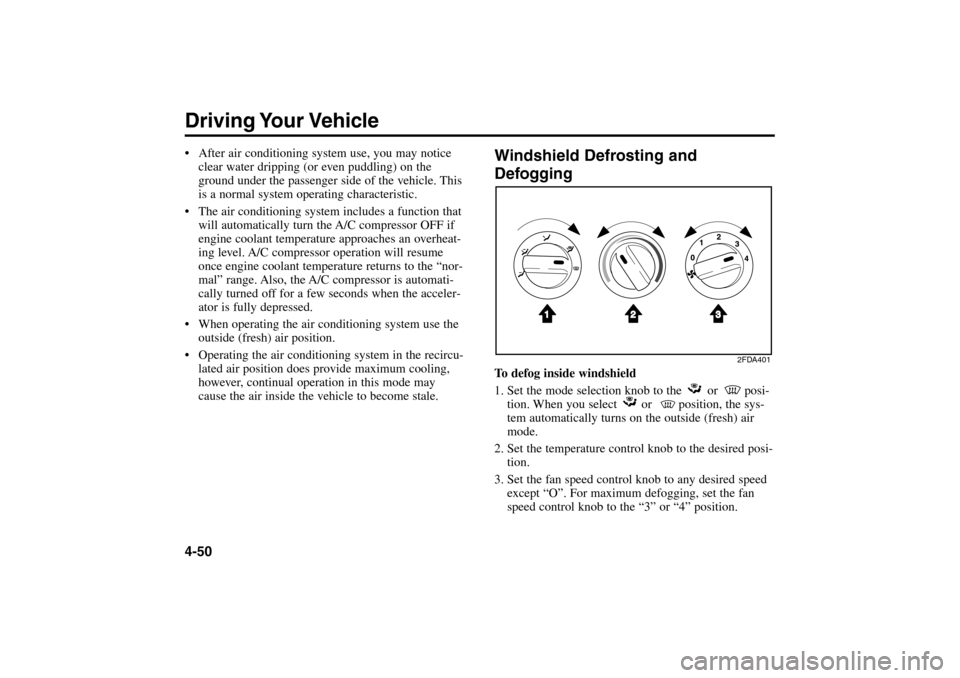
Windshield Defrosting and
DefoggingTo defog inside windshield
1. Set the mode selection knob to the or posi-
tion. When you select or position, the sys-
tem automatically turns on the outside (fresh) air
mode.
2. Set the temperature control knob to the desired posi-
tion.
3. Set the fan speed control knob to any desired speed
except “O”. For maximum defogging, set the fan
speed control knob to the “3” or “4” position.
1
2
3
Driving Your Vehicle4-50 After air conditioning system use, you may notice
clear water dripping (or even puddling) on the
ground under the passenger side of the vehicle. This
is a normal system operating characteristic.
The air conditioning system includes a function that
will automatically turn the A/C compressor OFF if
engine coolant temperature approaches an overheat-
ing level. A/C compressor operation will resume
once engine coolant temperature returns to the “nor-
mal” range. Also, the A/C compressor is automati-
cally turned off for a few seconds when the acceler-
ator is fully depressed.
When operating the air conditioning system use the
outside (fresh) air position.
Operating the air conditioning system in the recircu-
lated air position does provide maximum cooling,
however, continual operation in this mode may
cause the air inside the vehicle to become stale.
2FDA401
RIO ENG CNA 4.qxd 7/29/05 5:06 PM Page 50
Page 132 of 238
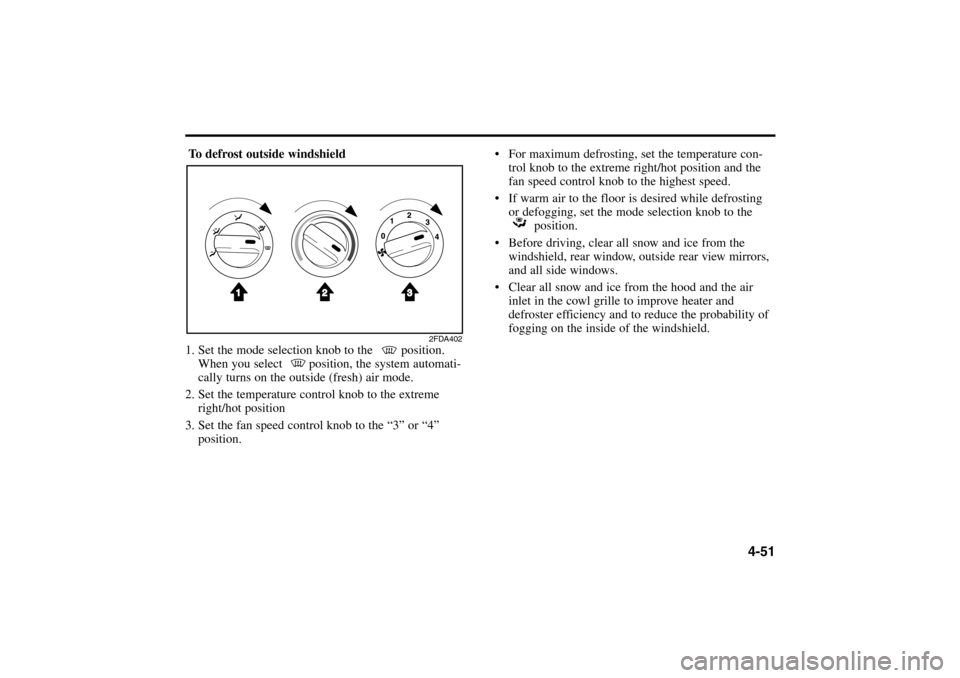
To defrost outside windshield
1. Set the mode selection knob to the position.
When you select position, the system automati-
cally turns on the outside (fresh) air mode.
2. Set the temperature control knob to the extreme
right/hot position
3. Set the fan speed control knob to the “3” or “4”
position.
1
2
3
For maximum defrosting, set the temperature con-
trol knob to the extreme right/hot position and the
fan speed control knob to the highest speed.
If warm air to the floor is desired while defrosting
or defogging, set the mode selection knob to the
position.
Before driving, clear all snow and ice from the
windshield, rear window, outside rear view mirrors,
and all side windows.
Clear all snow and ice from the hood and the air
inlet in the cowl grille to improve heater and
defroster efficiency and to reduce the probability of
fogging on the inside of the windshield.
4-51
2FDA402
RIO ENG CNA 4.qxd 7/29/05 5:06 PM Page 51
Page 133 of 238
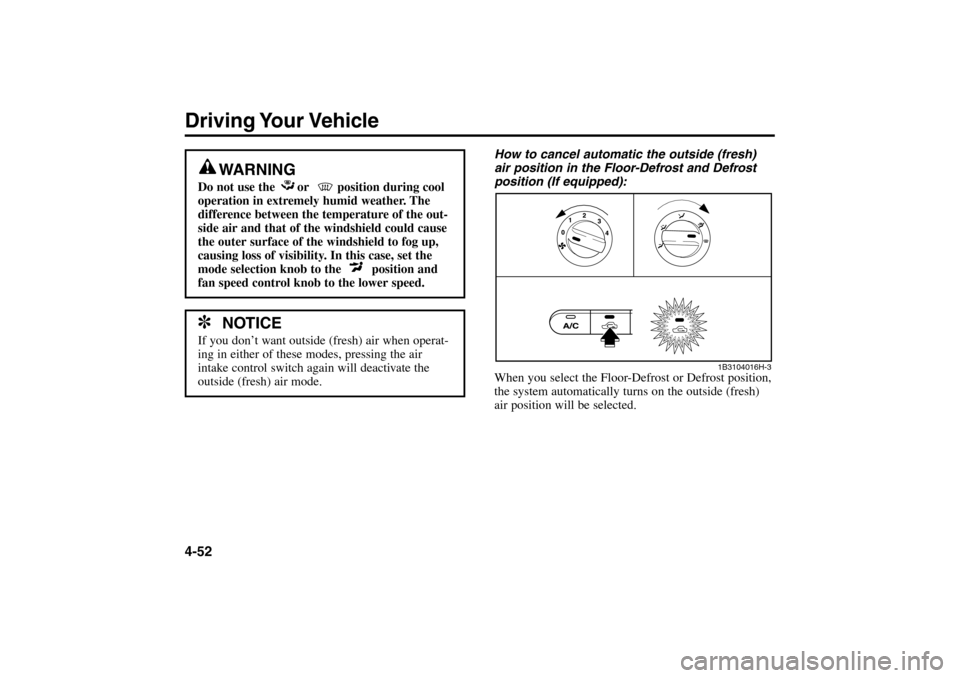
How to cancel automatic the outside (fresh)
air position in the Floor-Defrost and Defrost
position (If equipped):
When you select the Floor-Defrost or Defrost position,
the system automatically turns on the outside (fresh)
air position will be selected.
Driving Your Vehicle4-52
WARNING
Do not use the or position during cool
operation in extremely humid weather. The
difference between the temperature of the out-
side air and that of the windshield could cause
the outer surface of the windshield to fog up,
causing loss of visibility. In this case, set the
mode selection knob to the position and
fan speed control knob to the lower speed.✽
NOTICE
If you don’t want outside (fresh) air when operat-
ing in either of these modes, pressing the air
intake control switch again will deactivate the
outside (fresh) air mode.
1B3104016H-3
RIO ENG CNA 4.qxd 7/29/05 5:06 PM Page 52
Page 134 of 238
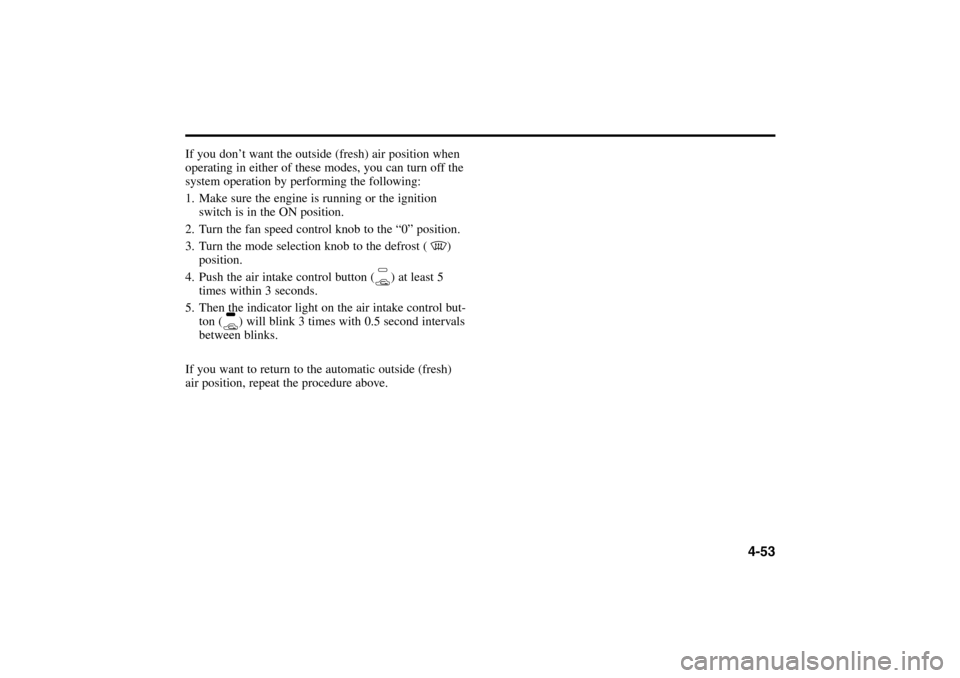
If you don’t want the outside (fresh) air position when
operating in either of these modes, you can turn off the
system operation by performing the following:
1. Make sure the engine is running or the ignition
switch is in the ON position.
2. Turn the fan speed control knob to the “0” position.
3. Turn the mode selection knob to the defrost ( )
position.
4. Push the air intake control button ( ) at least 5
times within 3 seconds.
5. Then the indicator light on the air intake control but-
ton ( ) will blink 3 times with 0.5 second intervals
between blinks.
If you want to return to the automatic outside (fresh)
air position, repeat the procedure above.
4-53
RIO ENG CNA 4.qxd 7/29/05 5:06 PM Page 53
Page 135 of 238

5-1
DRIVING TIPSFuel Requirements . . . . . . . . . . . . . . . . . . . . . . . . . . . .5-2
Emission Control System . . . . . . . . . . . . . . . . . . . . . . .5-3
Before Driving . . . . . . . . . . . . . . . . . . . . . . . . . . . . . . . .5-4
Suggestions for Economical Operation . . . . . . . . . . . .5-6
Special Driving Conditions . . . . . . . . . . . . . . . . . . . . . .5-7
Trailer Towing . . . . . . . . . . . . . . . . . . . . . . . . . . . . . . .5-12
Overloading . . . . . . . . . . . . . . . . . . . . . . . . . . . . . . . .5-13
Label Information . . . . . . . . . . . . . . . . . . . . . . . . . . . .5-13
5
RIO ENG CNA 5.qxd 7/29/05 5:07 PM Page 1
Page 136 of 238
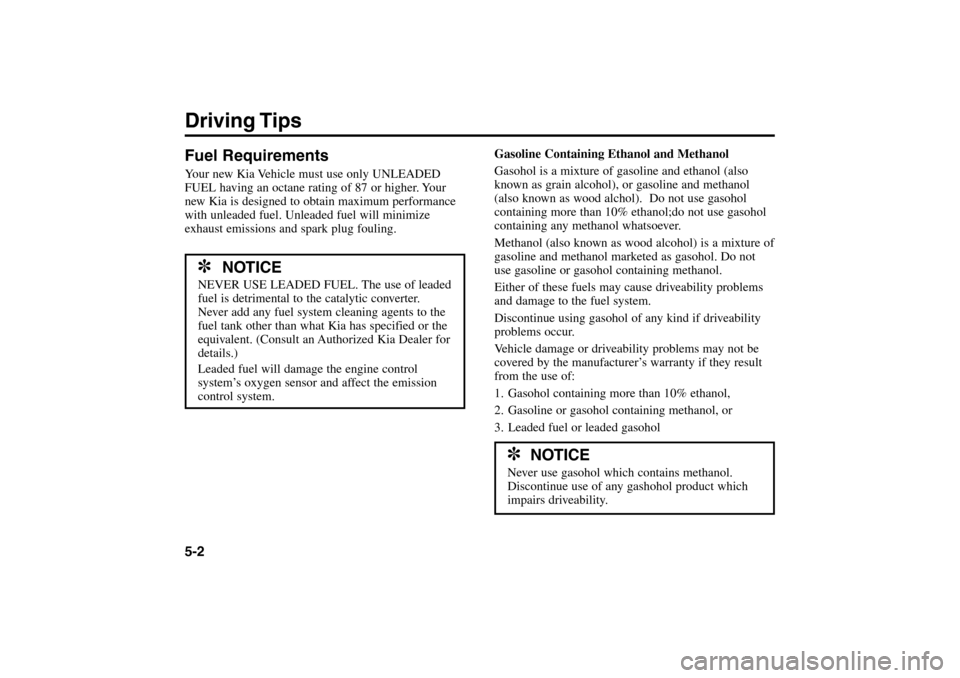
Fuel RequirementsYour new Kia Vehicle must use only UNLEADED
FUEL having an octane rating of 87 or higher. Your
new Kia is designed to obtain maximum performance
with unleaded fuel. Unleaded fuel will minimize
exhaust emissions and spark plug fouling.Gasoline Containing Ethanol and Methanol
Gasohol is a mixture of gasoline and ethanol (also
known as grain alcohol), or gasoline and methanol
(also known as wood alchol). Do not use gasohol
containing more than 10% ethanol;do not use gasohol
containing any methanol whatsoever.
Methanol (also known as wood alcohol) is a mixture of
gasoline and methanol marketed as gasohol. Do not
use gasoline or gasohol containing methanol.
Either of these fuels may cause driveability problems
and damage to the fuel system.
Discontinue using gasohol of any kind if driveability
problems occur.
Vehicle damage or driveability problems may not be
covered by the manufacturer’s warranty if they result
from the use of:
1. Gasohol containing more than 10% ethanol,
2. Gasoline or gasohol containing methanol, or
3. Leaded fuel or leaded gasoholDriving Tips5-2
✽
NOTICE
NEVER USE LEADED FUEL. The use of leaded
fuel is detrimental to the catalytic converter.
Never add any fuel system cleaning agents to the
fuel tank other than what Kia has specified or the
equivalent. (Consult an Authorized Kia Dealer for
details.)
Leaded fuel will damage the engine control
system’s oxygen sensor and affect the emission
control system.
✽
NOTICE
Never use gasohol which contains methanol.
Discontinue use of any gashohol product which
impairs driveability.
RIO ENG CNA 5.qxd 7/29/05 5:07 PM Page 2
Page 137 of 238
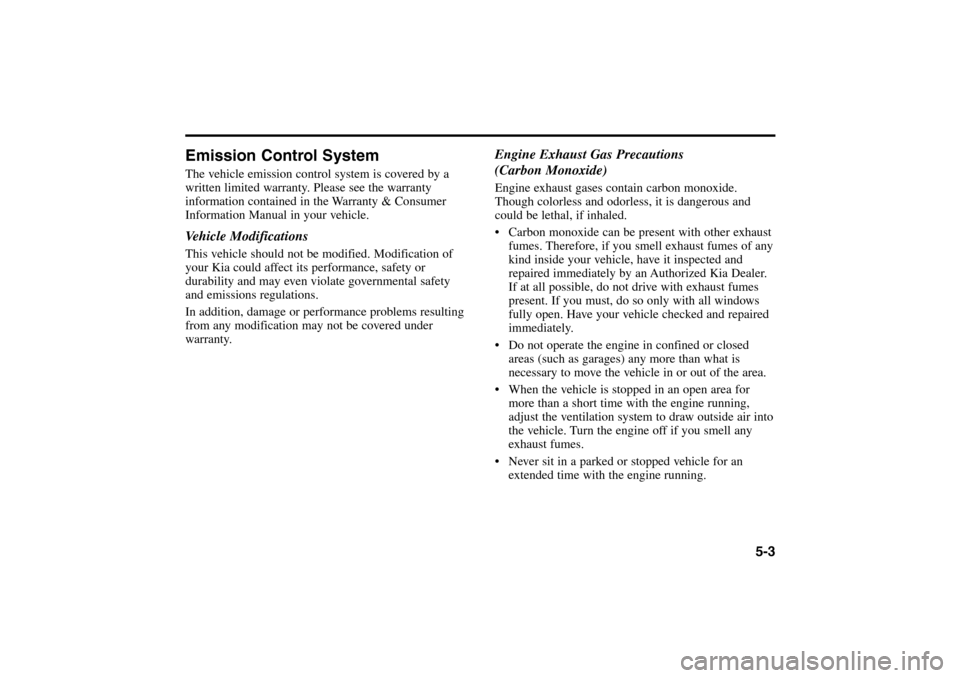
Emission Control SystemThe vehicle emission control system is covered by a
written limited warranty. Please see the warranty
information contained in the Warranty & Consumer
Information Manual in your vehicle.Vehicle ModificationsThis vehicle should not be modified. Modification of
your Kia could affect its performance, safety or
durability and may even violate governmental safety
and emissions regulations.
In addition, damage or performance problems resulting
from any modification may not be covered under
warranty.
Engine Exhaust Gas Precautions
(Carbon Monoxide)Engine exhaust gases contain carbon monoxide.
Though colorless and odorless, it is dangerous and
could be lethal, if inhaled.
Carbon monoxide can be present with other exhaust
fumes. Therefore, if you smell exhaust fumes of any
kind inside your vehicle, have it inspected and
repaired immediately by an Authorized Kia Dealer.
If at all possible, do not drive with exhaust fumes
present. If you must, do so only with all windows
fully open. Have your vehicle checked and repaired
immediately.
Do not operate the engine in confined or closed
areas (such as garages) any more than what is
necessary to move the vehicle in or out of the area.
When the vehicle is stopped in an open area for
more than a short time with the engine running,
adjust the ventilation system to draw outside air into
the vehicle. Turn the engine off if you smell any
exhaust fumes.
Never sit in a parked or stopped vehicle for an
extended time with the engine running.
5-3
RIO ENG CNA 5.qxd 7/29/05 5:07 PM Page 3
Page 138 of 238
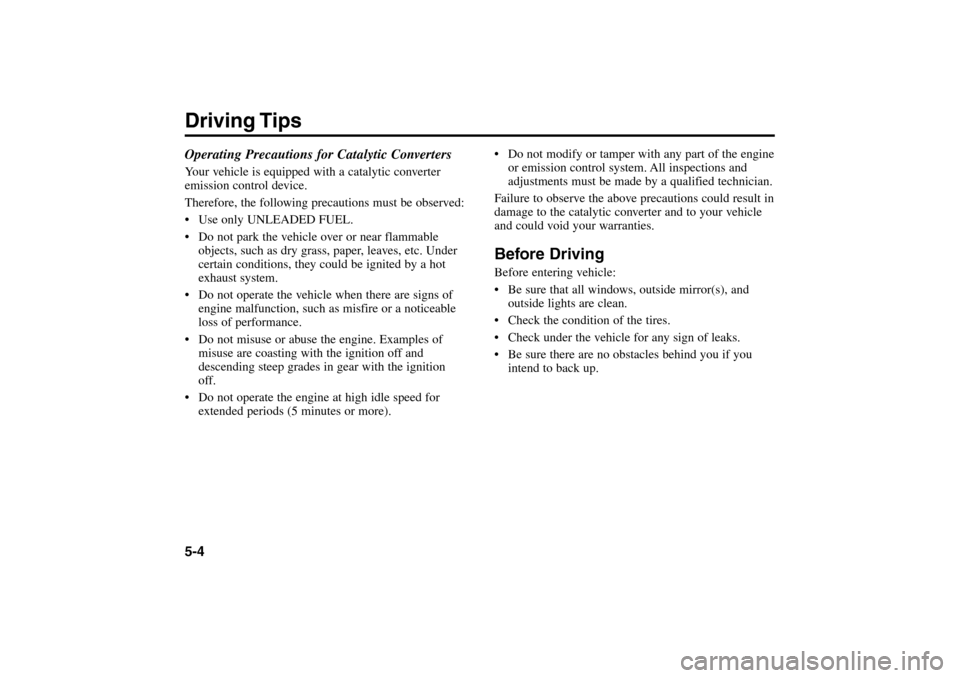
Operating Precautions for Catalytic ConvertersYour vehicle is equipped with a catalytic converter
emission control device.
Therefore, the following precautions must be observed:
Use only UNLEADED FUEL.
Do not park the vehicle over or near flammable
objects, such as dry grass, paper, leaves, etc. Under
certain conditions, they could be ignited by a hot
exhaust system.
Do not operate the vehicle when there are signs of
engine malfunction, such as misfire or a noticeable
loss of performance.
Do not misuse or abuse the engine. Examples of
misuse are coasting with the ignition off and
descending steep grades in gear with the ignition
off.
Do not operate the engine at high idle speed for
extended periods (5 minutes or more). Do not modify or tamper with any part of the engine
or emission control system. All inspections and
adjustments must be made by a qualified technician.
Failure to observe the above precautions could result in
damage to the catalytic converter and to your vehicle
and could void your warranties.
Before DrivingBefore entering vehicle:
Be sure that all windows, outside mirror(s), and
outside lights are clean.
Check the condition of the tires.
Check under the vehicle for any sign of leaks.
Be sure there are no obstacles behind you if you
intend to back up.
Driving Tips5-4
RIO ENG CNA 5.qxd 7/29/05 5:07 PM Page 4
Page 139 of 238
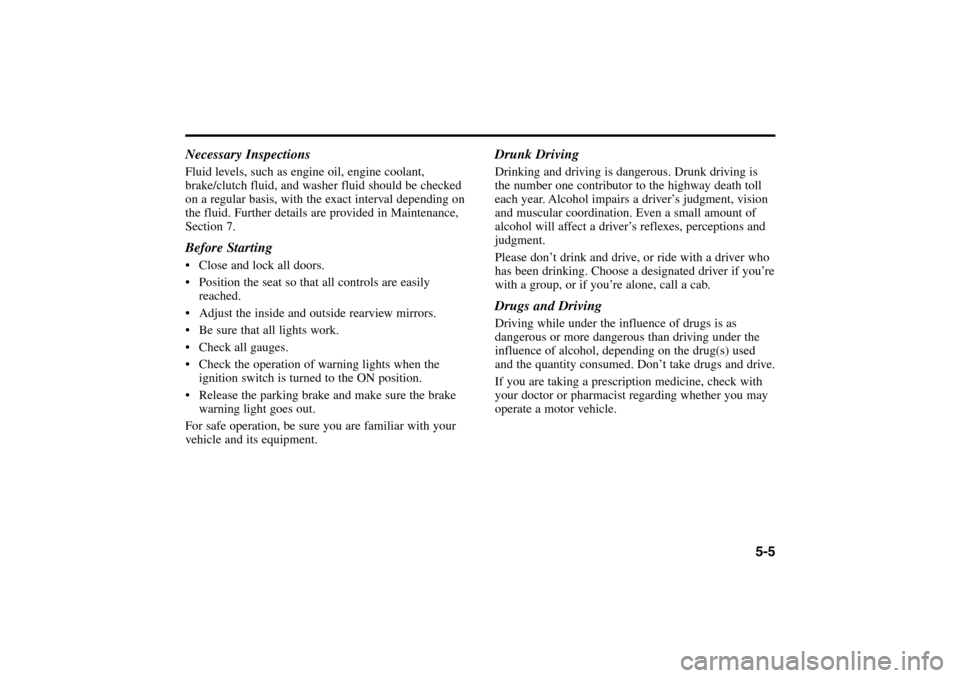
Necessary InspectionsFluid levels, such as engine oil, engine coolant,
brake/clutch fluid, and washer fluid should be checked
on a regular basis, with the exact interval depending on
the fluid. Further details are provided in Maintenance,
Section 7.Before Starting Close and lock all doors.
Position the seat so that all controls are easily
reached.
Adjust the inside and outside rearview mirrors.
Be sure that all lights work.
Check all gauges.
Check the operation of warning lights when the
ignition switch is turned to the ON position.
Release the parking brake and make sure the brake
warning light goes out.
For safe operation, be sure you are familiar with your
vehicle and its equipment.
Drunk DrivingDrinking and driving is dangerous. Drunk driving is
the number one contributor to the highway death toll
each year. Alcohol impairs a driver’s judgment, vision
and muscular coordination. Even a small amount of
alcohol will affect a driver’s reflexes, perceptions and
judgment.
Please don’t drink and drive, or ride with a driver who
has been drinking. Choose a designated driver if you’re
with a group, or if you’re alone, call a cab.Drugs and DrivingDriving while under the influence of drugs is as
dangerous or more dangerous than driving under the
influence of alcohol, depending on the drug(s) used
and the quantity consumed. Don’t take drugs and drive.
If you are taking a prescription medicine, check with
your doctor or pharmacist regarding whether you may
operate a motor vehicle.
5-5
RIO ENG CNA 5.qxd 7/29/05 5:07 PM Page 5
Page 140 of 238
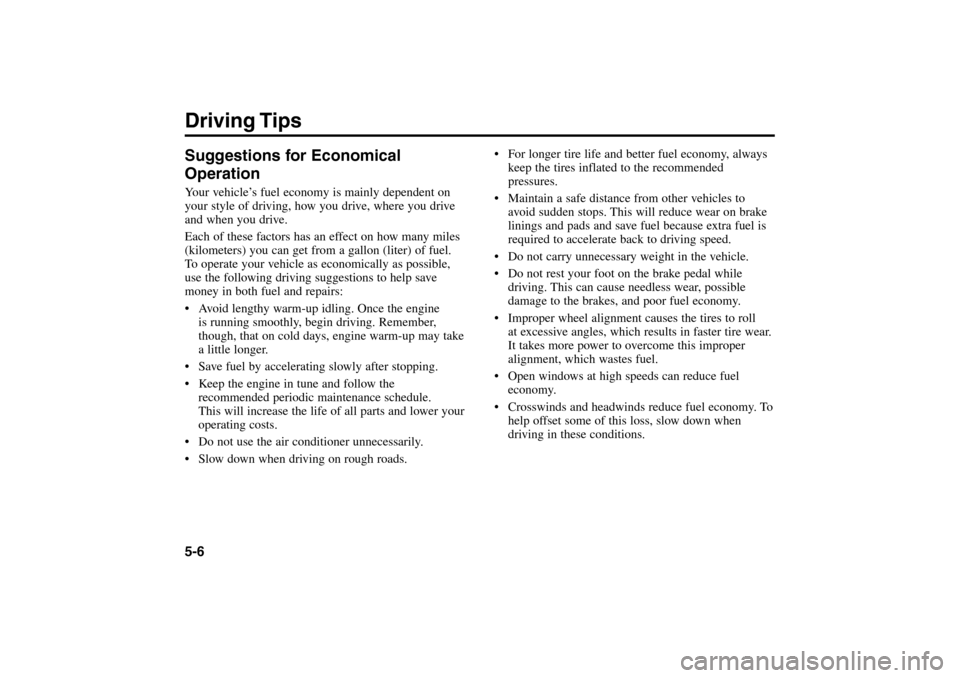
Suggestions for Economical
OperationYour vehicle’s fuel economy is mainly dependent on
your style of driving, how you drive, where you drive
and when you drive.
Each of these factors has an effect on how many miles
(kilometers) you can get from a gallon (liter) of fuel.
To operate your vehicle as economically as possible,
use the following driving suggestions to help save
money in both fuel and repairs:
Avoid lengthy warm-up idling. Once the engine
is running smoothly, begin driving. Remember,
though, that on cold days, engine warm-up may take
a little longer.
Save fuel by accelerating slowly after stopping.
Keep the engine in tune and follow the
recommended periodic maintenance schedule.
This will increase the life of all parts and lower your
operating costs.
Do not use the air conditioner unnecessarily.
Slow down when driving on rough roads. For longer tire life and better fuel economy, always
keep the tires inflated to the recommended
pressures.
Maintain a safe distance from other vehicles to
avoid sudden stops. This will reduce wear on brake
linings and pads and save fuel because extra fuel is
required to accelerate back to driving speed.
Do not carry unnecessary weight in the vehicle.
Do not rest your foot on the brake pedal while
driving. This can cause needless wear, possible
damage to the brakes, and poor fuel economy.
Improper wheel alignment causes the tires to roll
at excessive angles, which results in faster tire wear.
It takes more power to overcome this improper
alignment, which wastes fuel.
Open windows at high speeds can reduce fuel
economy.
Crosswinds and headwinds reduce fuel economy. To
help offset some of this loss, slow down when
driving in these conditions.Driving Tips5-6
RIO ENG CNA 5.qxd 7/29/05 5:07 PM Page 6